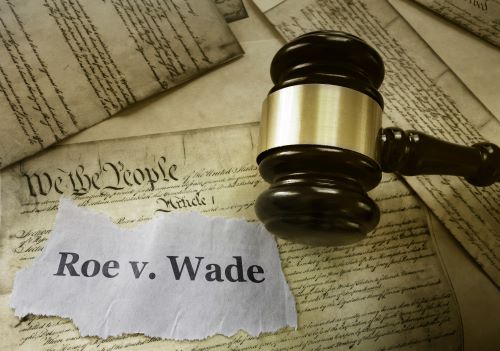What does the original Roe v. Wade really say?

Known as Jane Roe, Norma McCorvey was the plaintiff in the landmark 1973 U.S. Supreme Court decision in Roe v. Wade. Photo by Cynthia Johnson/Getty Images.
The U.S. Supreme Court appears poised to strike down Roe v. Wade, a landmark decision from 1973 that established a woman’s constitutional right to abortion.
Politico on Monday published a draft majority opinion written by Justice Samuel Alito in Dobbs v. Jackson Women’s Health Organization, a case that arose after Mississippi passed a law in 2018 that bans most abortions after 15 weeks of pregnancy. In siding with state officials in Mississippi, Alito also said it was time to overturn Roe, which he called “egregiously wrong from the start.”
Norma McCorvey, a single, pregnant woman from Dallas County in Texas, brought a federal lawsuit in 1970 against district attorney Henry Wade, alleging that Texas criminal abortion statutes that originated in 1854 were unconstitutional. According to the Supreme Court’s decision in Roe, McCorvey, who used the pseudonym Jane Roe, wished to terminate her pregnancy but said she was unable to get a legal abortion because the state only allowed the procedure when it was necessary to save the life of the mother.
Dr. James Hubert Hallford, a licensed physician who alleged that he had been arrested for violating the Texas abortion statutes, sought to intervene in Roe’s action. John and Mary Doe, a married couple who were told by their physician that Mary had a neurochemical disorder and would need an abortion if she became pregnant, also filed a companion complaint.
After consolidating their actions, the district court held that only Roe and Hallford had standing to sue and said declaratory, but not injunctive, relief was warranted. The court also ruled that the Texas abortion statutes were unconstitutionally vague and infringed the plaintiffs’ rights under the Ninth and 14th Amendments.
 Image from Shutterstock.
Image from Shutterstock.
Roe and her co-appellants appealed directly to the Supreme Court on the injunctive rulings, and Wade cross-appealed the district court’s grant of declaratory relief to Roe and Hallford. Justice Harry Blackmun wrote the majority opinion for the court, and before moving into the heart of his arguments, he said neither Hallford nor John and Mary Doe had standing to sue Wade. Even though Roe had already given birth to her child by that time, he agreed that Roe did have standing to sue.
Blackmun contended that while the U.S. Constitution does not specifically mention a right of privacy, the Supreme Court has recognized the roots of a right of personal privacy in the First, Fourth, Fifth and Ninth Amendments, as well as in the concept of liberty guaranteed by the 14th Amendment. He said the court has also made it clear in these decisions that the right of personal privacy extends to activities relating to marriage, contraception, family relationships and child-rearing and education.
“This right of privacy, whether it be founded in the 14th Amendment’s concept of personal liberty and restrictions upon state action, as we feel it is, or, as the district court determined, in the Ninth Amendment’s reservation of rights to the people, is broad enough to encompass a woman’s decision whether or not to terminate her pregnancy,” Blackmun wrote. “The detriment that the State would impose upon the pregnant woman by denying this choice altogether is apparent.”
Blackmun pointed to potential problems, including physical and psychological harms associated with maternity and motherhood, and said it is up to a woman and her physician to consider them together. However, Blackmun also said the court disagreed that a woman should be able to terminate her pregnancy at any time.
He explained that the court’s decisions recognizing a right of privacy also acknowledge that states should be able to provide some regulation in areas protected by that right. For instance, he said, a state can assert its interests in maintaining medical standards and protecting human health and life.
 Norma McCorvey attends the March for Women’s Lives outside the U.S. Capitol on April 9, 1989. McCorvey was the plaintiff in Roe v. Wade. Photo by Ron Sachs/CNP/Getty Images.
Norma McCorvey attends the March for Women’s Lives outside the U.S. Capitol on April 9, 1989. McCorvey was the plaintiff in Roe v. Wade. Photo by Ron Sachs/CNP/Getty Images.
“The state does have an important and legitimate interest in preserving and protecting the health of the pregnant woman, whether she be a resident of the state or a nonresident who seeks medical consultation and treatment there, and that it has still another important and legitimate interest in protecting the potentiality of human life,” Blackmun wrote. “These interests are separate and distinct. Each grows in substantiality as the woman approaches term and, at a point during pregnancy, each becomes ‘compelling.’”
Blackmun wrote that the “compelling” point for the state is at a fetus’s viability, which indicates the ability to live outside a mother’s womb. He said this could happen between 24 and 28 weeks of pregnancy—during the first or second trimesters—and outlined a specific framework to protect a mother and a fetus.
In this framework, the decision to have an abortion is left to a woman and her physician within the first trimester of pregnancy. States may adopt reasonable regulations related to maternal health in the second trimester and can ban abortion except where it is necessary to protect the life or health of a mother in the third trimester.
In 1992, the Supreme Court affirmed in Planned Parenthood v. Casey that the Constitution protects a woman’s right to have an abortion before a fetus becomes viable. However, this decision also replaced the trimester framework with the “undue burden” test, which allows states to restrict abortion at all stages of pregnancy, as long as it does not impose an “undue burden” on a woman’s right to a previability abortion.
The National Women’s Law Center and National Constitution Center recently published articles that provide more analysis on the Roe decision.
In a statement released Tuesday, ABA President Reginald Turner said the ABA “remains committed to protecting the freedom of individual women to make the highly personal and complex decision of whether to have an abortion.”
“The American Bar Association has long supported the right to reproductive choice under existing Supreme Court precedents,” Turner said. “The association opposes any law that prevents access to a legal abortion and supports the rights of women to choose to terminate a pregnancy before fetal viability or to protect the life or health of the mother.
“Over the past 49 years, the right to choose to have an abortion before viability has become embedded in the fabric of our society. It has become a right that affects women in every way—from economics to health to career choices and family life. Reversing this right would undermine the stability of the law gained through our adherence to precedents; it would jeopardize the public’s faith in our legal institutions; and it would have a devastating effect on the expectations—and the lives—of millions of women,” he added.
See also:
ABAJournal.com: “What is the potential impact of the abortion case before the Supreme Court?”
ABAJournal.com: “In ‘devastating blow’ to abortion rights, top Texas court stymies suit to overturn restrictive law”
ABAJournal.com: “Supreme Court allows abortion providers to sue over Texas law but keeps law intact for now”
ABAJournal.com: “Chemerinsky: Ruling in abortion cases will greatly affect women’s lives but won’t end controversy”
ABAJournal.com: “ABA urges Supreme Court to rule US can sue to block unconstitutional Texas abortion law”
ABAJournal.com: “Idaho lawmakers pass abortion bill copying Texas; what can abortion-rights states do?”
Updated May 3 at 3:18 p.m. to include ABA President Reginald Turner’s statement.



